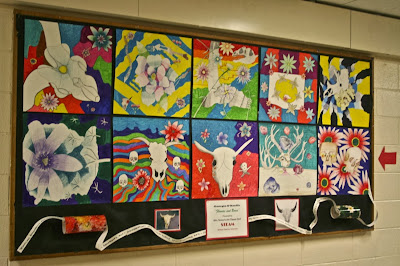This year’s STEAM program at GOPA and SOIT is made possible by William
Paterson University’s grant from the Geraldine R. Dodge Foundation. The current work at the secondary level
builds upon the success last year at the elementary and middle school levels. The
Dodge Grant has funded the Art Professors in Residence, art supplies and field
trips.
Last year at Paterson School 2, a grade K-8 school, first and second
grade bilingual students, working with Art Teacher Beth Porto in the school art
studio, created a five-foot by ten-foot mural that depicted the four seasons,
and that integrated art, math and science. Begun in September, the mural was
gradually added to throughout the year, and finally completed in June. First Grade Teacher Norma Menchon, Second
Grade Teacher Belinda Casais McBride, and Art Professor in Residence Simone Sandler
co-taught math topics (counting, odd and even numbers, and addition and
subtraction) and science topics (seasonal changes affecting animals and plants,
the phases of the moon, and weather) keyed to the district curriculum. These
lessons generated artwork that was incorporated into the mural. The mural now hangs in the hallway of
School 2, on permanent display.

At Paterson School 7, a grade 5 to 8 middle school, Art Professor in
Residence Myra Winter worked with Art Teacher Vernon Nealy, Math Teachers Rosa
Kopic and Melissa Bensh, and Science Teachers Marla Arrington and Mary Bertino. Team teaching among these educators brought
art into the other content areas. For
example, on a field trip to the American Museum of Natural
History, students attended a special program, “Spiders Alive!” Upon their return they created spider
presentation boxes using chipboard, binding fabric, and decorative papers. This required detailed measurement to
achieve the correct angles and proportions. They included all the scientific information they had
learned about spiders, and used the boxes as 3D graphic organizers to write a
research paper about spiders.
Another lesson focused upon the concepts of
volume and surface area. Students
made a variety of sizes of rectangular prisms using colored paper, and then
built a 3D sculpture with those prisms.
They calculated the volume and surface area of their prisms, and
calculated the relationships between them. They then did the same with their final sculpture.
The culminating event of School 7’s STEAM program was a “Creativity
Fair” held in May, in which parents and community members were invited to an
evening program to view the student work.

Evaluation by the WPU Geraldine R. Dodge Grant coordinator showed
improved results on math assessments and improved attitudes toward math and
science at both schools.


 WPU
K-12 Art Education Practicum Student: Marjiana Korunoska created and
taught a SPACE inspired art lesson in Mrs. Simon's SOIT art class
recently.
WPU
K-12 Art Education Practicum Student: Marjiana Korunoska created and
taught a SPACE inspired art lesson in Mrs. Simon's SOIT art class
recently.
 The lesson had a clear objective keyed to the NJ Core Curriculum Standards in Art. It also had a Demon-stration of Learning (DOL) that evaluated whether students had achieved that objective.
The lesson had a clear objective keyed to the NJ Core Curriculum Standards in Art. It also had a Demon-stration of Learning (DOL) that evaluated whether students had achieved that objective. 



























